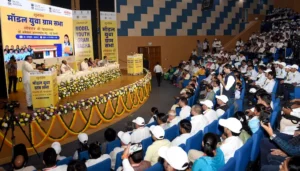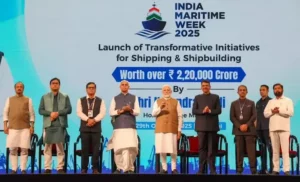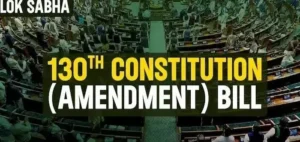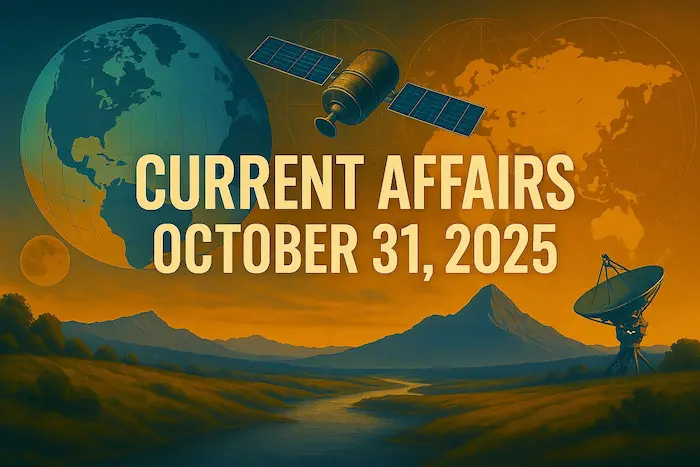1. Model Youth Gram Sabha (MYGS) Initiative – Polity

Why in News
The Central Government, in collaboration with the Ministry of Education and the Ministry of Tribal Affairs, launched the Model Youth Gram Sabha (MYGS) on 30 October 2025 in New Delhi.
Key Highlights of the Initiative
Launched by: Ministry of Panchayati Raj, Ministry of Education, Ministry of Tribal Affairs
Objective: To enhance youth participation in grassroots democracy by simulating Gram Sabha sessions in schools
Schools Covered: Over 1,000 schools, including:
Jawahar Navodaya Vidyalayas (JNVs)
Eklavya Model Residential Schools (EMRSs)
State Government Schools
Alignment with NEP 2020:
Focus on civic education and local self-governance
Aims to promote democracy, accountability, leadership, and transparency
Significance
Promotes awareness about democratic processes at the village level
Encourages active citizenship among school students
Builds leadership skills and instills civic values
Strengthens the functioning of Panchayati Raj Institutions (PRIs) by preparing an informed youth base
Back2Basics: Gram Sabha
Defined in: Article 243(b) of the Constitution of India
Who are members: All registered voters of the village (18 years and above)
Key Functions:
Approves village budgets and welfare schemes
Conducts social audits
Monitors Gram Panchayat functioning
Meeting Frequency: 2 to 4 times annually, generally on national days
Authority: Meetings are organized by the Panchayat Secretary with the Sarpanch’s approval
Quorum Rule: At least 10% of total members or minimum 50 villagers
Democratic Role: Foundation of Swaraj and direct democracy in India
Exam Connect – Possible Questions
Prelims
1. The Model Youth Gram Sabha (MYGS) initiative aims to
A. Enhance agricultural productivity through technology
B. Encourage youth engagement in grassroots governance
C. Promote entrepreneurship in rural women
D. Improve sanitation infrastructure in villages
Answer: B. Encourage youth engagement in grassroots governance
2. Under the Indian Constitution, the term “Gram Sabha” is defined in
A. Article 243D
B. Article 243G
C. Article 243(b)
D. Article 40
Answer: C. Article 243(b)
Mains
1.Discuss the significance of the Model Youth Gram Sabha (MYGS) initiative in promoting grassroots democracy and civic education among youth.
2.Examine the constitutional role of the Gram Sabha in India. How can youth-focused programs like MYGS strengthen its functioning and relevance in the modern context?
2. Koyla Shakti Dashboard and CLAMP Portal –Economy

Why in News
The Union Minister of Coal and Mines recently launched two major digital platforms:
Koyla Shakti Dashboard
Coal Land Acquisition, Management, and Payment (CLAMP) Portal
These platforms aim to modernize the coal sector through digital governance, transparency, and operational efficiency.
Key Features & Takeaways
1. Koyla Shakti Dashboard
A centralized digital platform developed by the Ministry of Coal to integrate and manage the entire coal value chain.
Key Functions:
Data Integration: Collects data from Coal PSUs, Indian Railways, ports, and power utilities
Real-Time Analytics: Uses AI-based tools for:
Demand forecasting
Coal dispatch planning
Logistics optimization
Transparency and Governance:
Offers real-time dashboards for policymakers
Aids in resource allocation and production planning
Ensures better monitoring of coal movement and supply
Operational Benefits:
Reduces bottlenecks
Increases dispatch and supply chain efficiency
Promotes inter-agency coordination
Significance:
A major digital governance reform in the coal sector
Enhances India’s energy security by ensuring efficient coal supply
2. CLAMP Portal (Coal Land Acquisition, Management and Payment)
A centralized online system to manage land acquisition, compensation, and rehabilitation in coal-bearing areas.
Key Features:
Secure Interface: Integrates land records and compensation payments
Transparency: Real-time tracking of:
Land acquisition status
Disbursal of payments to landowners
Institutional Coordination: Connects coal PSUs with:
State revenue departments
Local administration
Efficiency Gains:
Reduces paperwork
Speeds up clearance processes
Improves legal compliance
Community-Centric Approach:
Digital grievance redressal system
Ensures justice and transparency for affected communities
Significance:
Ensures just compensation and faster resettlement in mining areas
Strengthens ease of doing business in the coal sector
Exam Connect – Possible Questions
Prelims
1. The Koyla Shakti Dashboard recently launched by the Government of India is primarily aimed at
A. Monitoring coal production and logistics using real-time data
B. Regulating environmental clearances for mining
C. Increasing the price of imported coal
D. Conducting geological surveys
Answer: A. Monitoring coal production and logistics using real-time data
2. What is the main objective of the CLAMP Portal?
A. Monitoring exports of coal from India
B. Integrating land acquisition and compensation processes in coal-bearing areas
C. Promoting private sector mining through e-auctions
D. Supervising underground coal gasification
Answer: B. Integrating land acquisition and compensation processes in coal-bearing areas
Mains
1. Discuss how digital platforms like the Koyla Shakti Dashboard and the CLAMP Portal can transform coal sector governance in India.
2.How does digitization of land acquisition and compensation processes through portals like CLAMP contribute to transparency and public trust in resource extraction projects?
3. Rehabilitation Council of India (RCI) – Reforms in Governance – Governance

Why in News
The Rehabilitation Council of India (RCI) has introduced key reforms to improve transparency, efficiency, and inclusivity within India’s national rehabilitation framework.
Key Takeaways
RCI is a statutory body under the Ministry of Social Justice and Empowerment.
Established under the Rehabilitation Council of India Act, 1992; became a statutory body on 22 June 1993.
Initially registered as a society in 1986, later endowed with regulatory powers.
Vision & Objectives
Mission: To build a skilled, ethical, and inclusive rehabilitation workforce in line with:
India’s disability rights legislation
International obligations under the UN Convention on the Rights of Persons with Disabilities (UNCRPD)
Goal: Improve the quality, accessibility, and accountability of rehabilitation services across India.
Regulatory & Governance Functions
Central Rehabilitation Register (CRR)
Maintains a national-level database of all certified rehabilitation professionals.
Ensures that only qualified professionals deliver rehabilitation services.
Oversight of Professional Categories
RCI governs 16 categories of rehabilitation professionals, including:
Special Educators
Audiologists
Physiotherapists
Occupational Therapists
Clinical Psychologists, etc.
Key Reforms Introduced
Streamlining of certification and registration processes
Greater integration with international standards of disability rights
Focus on inclusive and ethical education and practice
Enhanced transparency via digital tracking and regulation
Background Linkage: UNCRPD & India
India ratified the UN Convention on the Rights of Persons with Disabilities (UNCRPD) in 2007.
RCI reforms reflect efforts to comply with global standards in disability-inclusive development.
Exam Connect – Possible Questions
Prelims
1. The Rehabilitation Council of India (RCI) operates under
A. Ministry of Health and Family Welfare
B. Ministry of Human Resource Development
C. Ministry of Social Justice and Empowerment
D. Ministry of Women and Child Development
Answer: C. Ministry of Social Justice and Empowerment
2. The Central Rehabilitation Register (CRR) maintained by the RCI is related to
A. Monitoring of NGOs working in rural India
B. Registration of professionals in the field of rehabilitation
C. Listing of welfare schemes for SCs and STs
D. List of Accredited Special Schools in India
Answer: B. Registration of professionals in the field of rehabilitation
Mains
1.Discuss the role of the Rehabilitation Council of India (RCI) in strengthening the governance of rehabilitation services in India. How do recent reforms enhance transparency and inclusivity?
2.How do institutions like RCI help India meet its obligations under international conventions like the UNCRPD? Evaluate the impact of such reforms on the delivery of disability-related services.
4. PM Modi’s Address at India Maritime Week 2025 – Maritime Sector Reforms and Vision – Economy

Why in News
Prime Minister Narendra Modi addressed the Maritime Leaders Conclave and chaired the Global Maritime CEO Forum during India Maritime Week 2025 in Mumbai.
The event has grown from a national forum in 2016 to a global summit, welcoming leaders from over 85 countries.
Key Highlights of India Maritime Week 2025
Theme:
“Uniting Oceans, One Maritime Vision”
Aimed at positioning India as a global maritime hub and leader in the Blue Economy.
India’s Maritime Importance:
11,000 km coastline across 13 coastal states
Exclusive Economic Zone (EEZ): 23.7 lakh sq km
Maritime regions support 800 million people
Coastal states contribute ~60% of India’s GDP
Strategic Vision: Maritime Amrit Kaal Vision 2047
PM Modi outlined a long-term strategic vision for transforming India’s maritime sector, built on four key pillars:
1.Port-led development
2.Shipping and shipbuilding
3.Seamless logistics
4.Maritime skill-building
Aim: Quadruple port capacity and increase share of containerized cargo, transforming India into a global maritime power.
Major Achievements (2024–25)
| Initiative | Description |
|---|---|
| Vizhinjam Port | Operational as India’s first deep-water international transshipment hub, hosted the world’s largest container vessel. |
| Kandla Port | Launched India’s first megawatt-scale indigenous green hydrogen facility. |
| JNPT (Bharat Mumbai Terminal) | Doubled capacity in Phase 2 – represents the largest FDI in Indian port infrastructure. |
| Record Cargo | Major ports handled all-time high cargo volumes; turnaround time & efficiency significantly improved. |
Next-Generation Maritime Reforms
Replaced colonial-era shipping laws
Enacted:
New Merchant Shipping Act – aligns Indian law with global standards
Coastal Shipping Act – simplifies coastal trade and logistics
One Nation, One Port Process – standardized procedures, reduced documentation, improved ease of doing business
India’s Blue Economy & Green Growth Focus
Sustainable coastal development and green logistics
₹70,000 crore investment in shipbuilding, with:
Infrastructure asset status for large ships
Lower financing costs, increased employment
Boost to cruise tourism, inland waterways, and clean energy shipping
Maritime India Vision Achievements (2015–2025)
| Area | Growth |
|---|---|
| Operational Waterways | Increased from 3 to 32 |
| Inland Cargo Movement | Rose by 700% |
| Major Port Capacity | Doubled |
| Net Annual Surplus (Ports) | Increased 9x |
| Turnaround Time (Vessels) | Reduced from 96 to 48 hours |
| Average Container Dwell Time | Under 3 days |
| Indian Seafarers | Increased from 1.25 lakh to 3 lakh |
Global Cooperation & Strategic Outlook
India aims to act as a “steady lighthouse” for global maritime stability and supply chain resilience.
India–Middle East–Europe Economic Corridor (IMEC) seen as a transformative trade route.
Commitment to supporting:
Small Island Developing States (SIDS)
Least Developed Countries (LDCs) through technology, training & maritime infrastructure
New Announcements
Mega Port at Vadhavan, Maharashtra to expand India’s port handling capacity
Recognition of Chhatrapati Shivaji Maharaj’s maritime legacy as an inspiration for India’s maritime future
Exam Connect – Possible Questions
Prelims
1. Which of the following ports in India has recently become operational as the country’s first deep-water international transshipment hub?
. Kandla Port
B. Vizhinjam Port
C. Paradip Port
D. Vadhavan Port
Answer: B. Vizhinjam Port
2. The India–Middle East–Europe Economic Corridor (IMEC), as highlighted during India Maritime Week 2025, primarily aims to
A. Enhance nuclear trade between the regions
B. Promote clean energy logistics and redefine global trade routes
C. Expand cultural tourism in Asia
D. Create a military alliance for maritime security
Answer: B. Promote clean energy logistics and redefine global trade routes
Mains
1.Discuss the strategic significance of the Maritime Amrit Kaal Vision 2047 in transforming India into a global maritime power. Highlight key reforms and achievements in the sector.
2.Examine how initiatives like India Maritime Week and projects like the India–Middle East–Europe Economic Corridor enhance India’s role in global maritime trade and supply chain resilience.
5. A Decade After the Paris Accord: An Unstoppable Transition – Environment

Why in News
The year 2025 marks 10 years since the adoption of the Paris Agreement at COP21 in 2015. The milestone is being commemorated at COP30, held in Belém, Brazil, where nations are assessing progress toward the goal of climate neutrality by 2050.
Key Takeaways
The Paris Agreement has driven a global shift towards sustainable energy, low-carbon development, and international climate collaboration.
Climate finance, natural carbon sinks, and the role of non-state actors are emerging as critical pillars of global climate action.
The agreement has embedded principles of equity, common but differentiated responsibilities (CBDR), and science-based policymaking.
Impact of the Paris Agreement Over the Decade
1. Transition to Renewable Energy
The Agreement accelerated the move from fossil fuels to renewables such as solar, wind, and hydro.
Clean energy has become mainstream, enabling:
Job creation in green industries
Reduced dependence on coal and oil
Decentralized energy access, especially in rural and island nations
2. End of Fossil Dominance
A decade ago, fossil fuels dominated global energy systems.
Now, policy incentives, technological innovation, and climate diplomacy have made clean energy cost-competitive and widely adopted.
3. Global Policy Integration
The Agreement enforces:
Nationally Determined Contributions (NDCs)
Climate neutrality goals by 2050
CBDR-RC (Common But Differentiated Responsibilities and Respective Capabilities)
Encourages developed countries to show higher ambition, while supporting developing nations through finance and technology.
4. Strengthening Multilateral Cooperation
International Solar Alliance (ISA)
Launched by India and France at COP21
Now includes 120+ countries
Focus on:
Solar infrastructure
Capacity building
Green financing
A successful example of South-South cooperation in climate diplomacy
5. Climate Finance Evolution
Expansion of instruments like:
Green Climate Fund (GCF)
Loss and Damage Fund
Innovative debt-for-climate swaps
Emphasis on:
Predictability
Access for vulnerable nations
Bridging equity gaps between Global North and Global South
6. Role of Natural Carbon Sinks
Focus on preserving and enhancing:
Forests
Mangroves
Wetlands
Oceans
Seen as nature-based solutions for:
Carbon sequestration
Climate resilience
Biodiversity conservation
7. Empowerment of Non-State Actors
Local governments, private sector, NGOs, and citizens are increasingly vital.
Bottom-up initiatives are shaping climate outcomes, e.g.:
Urban green infrastructure
Community-led solar programs
Corporate net-zero pledges
8. Science and Climate Misinformation
IPCC’s scientific assessments continue to guide global policy.
Combatting disinformation is critical to maintaining public support and policy coherence.
Exam Connect – Possible Questions
Prelims
1. Which of the following international initiatives was jointly launched by India and France during COP21 to promote solar energy?
A. Global Green Grid Initiative
B. International Solar Alliance
C. Clean Energy Partnership
D. Global Solar Platform
Answer: B. International Solar Alliance
2. Which of the following is NOT considered a natural carbon sink?
A. Mangrove forests
B. Oceans
C. Urban roads
D. Tropical rainforests
Answer: C. Urban roads
Mains
1.Evaluate the role of the Paris Agreement in transforming global climate governance and driving the energy transition. How effective has it been in achieving its goals a decade later?
2.Discuss the significance of natural carbon sinks in achieving climate neutrality. How can India integrate biodiversity conservation with its climate action goals?
6. The Constitution (130th Amendment) Bill, 2025 – Ministerial Removal and Its Controversies – Polity

Why in News
The Constitution (One Hundred and Thirtieth Amendment) Bill, 2025 has been introduced with the intent to strengthen constitutional morality and political accountability.
It proposes mandatory removal of Ministers (including PM and CMs) if they are in custody for 30 consecutive days in cases punishable with five or more years of imprisonment.
While it aims to preserve the integrity of public office, the Bill has raised serious constitutional and legal concerns.
Key Provisions of the Bill
Amendments proposed to Articles 75, 164, and 239AA of the Constitution.
If a Minister (including PM or CM) is in custody for 30 consecutive days, they must be removed from office.
The President or Governor is bound to act on the advice of the PM or CM to remove the Minister.
The threshold for removal: The alleged offence must be punishable with five or more years of imprisonment.
Major Concerns and Contentious Issues
1. Discretionary Power of Arrest
Arrest is not mandatory and depends on the discretion of investigating agencies.
Risk: Politically motivated arrests could lead to abuse of power and targeted removals.
2. Presumption of Innocence vs Ministerial Disqualification
Under Indian law, an accused is presumed innocent until proven guilty.
This Bill allows removal before any conviction, potentially violating due process.
3. Judicial Timelines & Bail Issues
The 30-day custody period does not consider bail timelines.
Could lead to removal even before a default bail application is processed.
Creates a situation where Ministers must choose between resignation and prolonged custody, affecting governance continuity.
4. Potential for Political Misuse
May be used as a political tool to remove opponents by initiating selective investigations.
Weakens democratic fairness and opens doors to partisan targeting.
5. Administrative Instability
Sudden removal of Ministers, especially Chief Ministers or Prime Minister, may lead to:
Policy paralysis
Governance disruptions
Frequent leadership changes, especially in volatile coalition governments
Broader Constitutional and Ethical Debate
Balancing Accountability and Justice
While ethical governance is critical, mechanisms must:
Uphold constitutional values
Avoid pre-judging guilt
Prevent misuse of state power
Constitutional Morality vs Legal Formalism
True ministerial accountability should derive from:
Political responsibility
Public transparency
Not just from legalistic triggers
Exam Connect – Possible Questions
Prelims
1. The Constitution (130th Amendment) Bill proposes changes to which of the following Articles?
A. 72, 164, 239AA
B. 75, 164, 239AA
C. 74, 76, 164
D. 75, 166, 239
Answer: B. 75, 164, 239AA
2. As per the proposed 130th Amendment Bill, a Minister must be removed from office if they are in custody for how many consecutive days?
A. 15 days
B. 21 days
C. 30 days
D. 45 days
Answer: C. 30 days
Mains
1.Critically examine the constitutional and ethical implications of the Constitution (130th Amendment) Bill, 2025. How does it affect the balance between political accountability and rule of law?
2.While aiming to promote clean politics, the 130th Amendment Bill raises serious concerns about misuse of state power. Discuss how India can ensure ethical governance without compromising constitutional safeguards.

